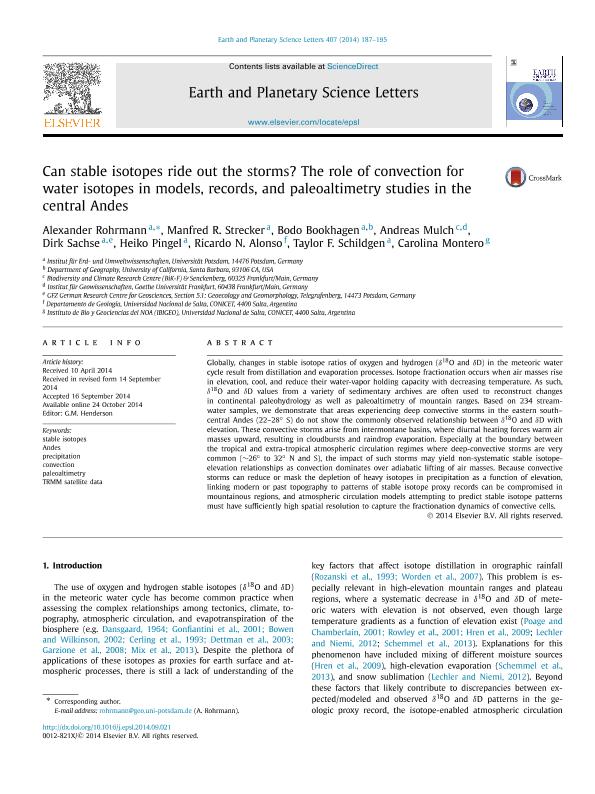Mostrar el registro sencillo del ítem
dc.contributor.author
Rohrmann, Alexander
dc.contributor.author
Strecker, Manfred R.
dc.contributor.author
Bookhagen, Bodo
dc.contributor.author
Mulch, Andreas
dc.contributor.author
Sachse, Dirk
dc.contributor.author
Pingel, Heiko
dc.contributor.author
Alonso, Ricardo Narciso

dc.contributor.author
Schildgen, Taylor F.
dc.contributor.author
Montero Lopez, Maria Carolina

dc.date.available
2016-06-24T19:46:30Z
dc.date.issued
2014-10-24
dc.identifier.citation
Rohrmann, Alexander; Strecker, Manfred R.; Bookhagen, Bodo; Mulch, Andreas; Sachse, Dirk; et al.; Can stable isotopes ride out the storms? The role of convection for water isotope in models, records, and paleoaltimetry studies in the central Andes; Elsevier; Earth and Planetary Science Letters; 407; 24-10-2014; 187-195
dc.identifier.issn
0012-821X
dc.identifier.uri
http://hdl.handle.net/11336/6267
dc.description.abstract
Abstract: Globally, changes in stable isotope ratios of oxygen and hydrogen (δ18Oand δD) in the meteoric water cycle result from distillation and evaporation processes. Isotope fractionation occurs when air masses rise in elevation, cool, and reduce their water-vapor holding capacity with decreasing temperature. Assuch, δ18Oand δDvalues from a variety of sedimentary archives are often used to reconstruct changes in continental paleohydrology as well as paleoaltimetry of mountain ranges. Based on 234 stream-water samples, wedemonstrate that areas experiencing deep convective storms in the eastern south?central Andes (22?28◦S) do not show the commonly observed relationship between δ18Oand δDwith elevation. These convective storms arise from intermontane basins, where diurnal heating forces warm air masses upward, resulting in cloudbursts and raindrop evaporation. Especially at the boundary between the tropical and extra-tropical atmospheric circulation regimes where deep-convective storms are very common (∼26◦to 32◦N andS), the impact of such storms may yield non-systematic stable isotope-elevation relationships as convection dominates over adiabatic lifting of air masses. Because convective storms can reduce or mask the depletion of heavy isotopes in precipitation as a function of elevation, linking modern or past topography to patterns of stable isotope proxy records can be compromised in mountainous regions, and atmospheric circulation models attempting to predict stable isotope patterns must have sufficiently high spatial resolution to capture the fractionation dynamics of convective cells.
dc.format
application/pdf
dc.language.iso
eng
dc.publisher
Elsevier

dc.rights
info:eu-repo/semantics/openAccess
dc.rights.uri
https://creativecommons.org/licenses/by-nc-nd/2.5/ar/
dc.subject
Isotopes
dc.subject
Andes
dc.subject
Precipitation
dc.subject
Convection
dc.subject.classification
Geoquímica y Geofísica

dc.subject.classification
Ciencias de la Tierra y relacionadas con el Medio Ambiente

dc.subject.classification
CIENCIAS NATURALES Y EXACTAS

dc.title
Can stable isotopes ride out the storms? The role of convection for water isotope in models, records, and paleoaltimetry studies in the central Andes
dc.type
info:eu-repo/semantics/article
dc.type
info:ar-repo/semantics/artículo
dc.type
info:eu-repo/semantics/publishedVersion
dc.date.updated
2016-06-16T15:51:52Z
dc.journal.volume
407
dc.journal.pagination
187-195
dc.journal.pais
Países Bajos

dc.journal.ciudad
Amsterdam
dc.description.fil
Fil: Rohrmann, Alexander. Universität Potsdam. Institut für Erd- und Umweltwissenschaften; Alemania
dc.description.fil
Fil: Strecker, Manfred R.. Universität Potsdam. Institut für Erd- und Umweltwissenschaften; Alemania
dc.description.fil
Fil: Bookhagen, Bodo. Universität Potsdam. Institut für Erd- und Umweltwissenschaften; Alemania. University of California at Los Angeles; Estados Unidos
dc.description.fil
Fil: Mulch, Andreas. Biodiversity and Climate Research Centre; Alemania. Goethe Universität Frankfurt. Institut für Geowissenschaften; Alemania
dc.description.fil
Fil: Sachse, Dirk. Universität Potsdam. Institut für Erd- und Umweltwissenschaften; Alemania. GFZ German Research Centre for Geosciences; Alemania
dc.description.fil
Fil: Pingel, Heiko. Universität Potsdam. Institut für Erd- und Umweltwissenschaften; Alemania
dc.description.fil
Fil: Alonso, Ricardo Narciso. Universidad Nacional de Salta; Argentina
dc.description.fil
Fil: Schildgen, Taylor F.. Universität Potsdam. Institut für Erd- und Umweltwissenschaften; Alemania
dc.description.fil
Fil: Montero Lopez, Maria Carolina. Consejo Nacional de Investigaciones Científicas y Técnicas. Centro Científico Tecnológico Salta. Instituto de Bio y Geociencias del Noroeste Argentino; Argentina
dc.journal.title
Earth and Planetary Science Letters

dc.relation.alternativeid
info:eu-repo/semantics/altIdentifier/url/http://www.sciencedirect.com/science/article/pii/S0012821X14005767
dc.relation.alternativeid
info:eu-repo/semantics/altIdentifier/doi/http://dx.doi.org/10.1016/j.epsl.2014.09.021
dc.relation.alternativeid
info:eu-repo/semantics/altIdentifier/doi/10.1016/j.epsl.2014.09.021
Archivos asociados
